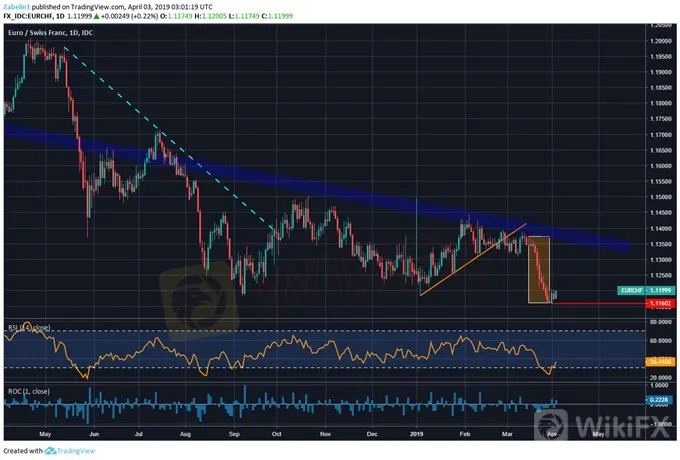简体中文
繁體中文
English
Pусский
日本語
ภาษาไทย
Tiếng Việt
Bahasa Indonesia
Español
हिन्दी
Filippiiniläinen
Français
Deutsch
Português
Türkçe
한국어
العربية
EUR/USD Eyeing Key Economic Growth Indicators in US and EU
Abstract:EURUSD will be watching tomorrows cascade of key economic growth indicators out of the US and EU as both economies slow against the backdrop of rising tensions.
In the last breath of March, EURUSD shaved off almost two percent following the release of numerous underperforming European economic reports and a less-than-optimistic outlook for inflation from ECB President Mario Draghi. The regional slowdown – particularly out of key Eurozone economies such as Germany and France – has emboldened Euro bears as the outlook progressively seems to deteriorate.
Tomorrow, a cascade of key growth indicators will be released, which if in line with the prevailing trend of underperformance in the region, may fall short of estimates and exert further pressure on the already-battered Euro. US ISM data will be released tomorrow, though given the recent trend of underperformance in US economic reports, it is also likely that the indicator will fall short of the 58.0 forecast.
Given that market sentiment is broadly less risk-inclined, it is possible that the US Dollar may rise if local data underperforms. This is due to the Greenbacks unparalleled liquidity and status as the world reserve currency. If growth out of the largest economy in the world appears to be in jeopardy, investors may flock to the Greenback because of an increased demand to park their capital in the safest and most liquid asset.
Lingering fears over the outcome of Brexit will likely continue to dominate headlines as UK lawmakers scramble to avoid a no-deal outcome by the April 12 deadline. There is also the increasing concern over the future of EU-US trade relations as policymakers from both sides prepare for a possible revival of a cross-Atlantic trade war.
As European-based event risks begin to take the spotlight, the Swiss Franc may further strengthen against the Euro if investors begin to pivot from chasing yields to preserving capital. CHF may outperform in this regard relative to the JPY because of its regional proximity to the EU-based event risk. This might explain why the Franc has prospered amid fears of what looks like an increasing probability of a no-deal Brexit.
Year-to-date, EURCHF has already lost over eight percent amid the economic and political turmoil the region faced in 2018 ranging from trade wars to the Italian budget crisis. If the current state of European affairs – politically and economically – worsen, bullish sentiment for Euro (or whats left of it) would likely evaporate and send EURCHF lower.
CHART OF THE DAY – EUR/CHF

Disclaimer:
The views in this article only represent the author's personal views, and do not constitute investment advice on this platform. This platform does not guarantee the accuracy, completeness and timeliness of the information in the article, and will not be liable for any loss caused by the use of or reliance on the information in the article.
Read more

Weekly British Pound Forecast: Inflation Report Due Ahead of BOE Meeting; Brexit Talks Ongoing
As Brexit talks persist, the BOE remains sidelined. And with the UK parliament prorogued, all attention is on UK PM Johnson's talks with his EU counterparts.

GBPUSD Price Rallies to a Six-Week High, Brexit Latest
GBPUSD has just hit its highest level since late-July and is eyeing further gains on a combination of a marginally stronger Sterling complex and a weak US dollar.

Crude Oil Prices at Risk if US Economic Data Cool Fed Rate Cut Bets
Crude oil prices may fall if upbeat US retail sales and consumer confidence data cool Fed rate cut bets and sour risk appetite across financial markets.

EURUSD Fails to Test 2019 Low, RSI Flashes Bullish Signal After ECB
EURUSD fails to test the 2019-low (1.0926) following the ECB meeting, with the Relative Strength Index (RSI) breaking out of the bearish formation carried over from June.
WikiFX Broker
Latest News
Tokyo Police Arrest 4 for Unregistered FX Trading Scheme
BSP Shuts Down Uno Forex Over Serious AML Violations
ACY Securities Expands Global Footprint with South Africa Acquisition
Rupee gains against Euro
WikiEXPO Global Expert Interview: The Future of Financial Regulation and Compliance
DFSA Warns of Fake Loan Approval Scam Using Its Logo
Consob Sounds Alarm: WhatsApp & Telegram Users Vulnerable to Investment Scams
CySEC Revokes UFX Broker Licence as Reliantco Halts Global Operations
GCash, Government to Launch GBonds for Easy Investments
Bitcoin ETF Options Get Closer to Reality with CFTC Clarification
Currency Calculator


